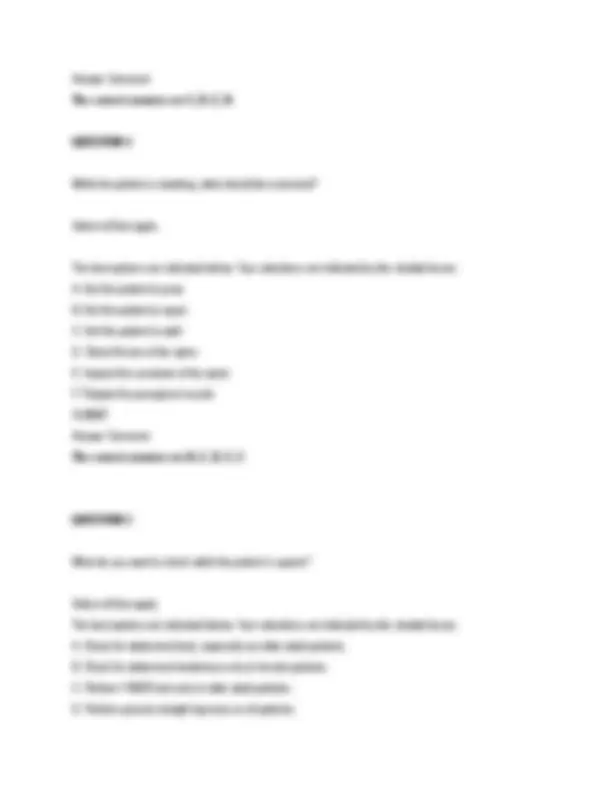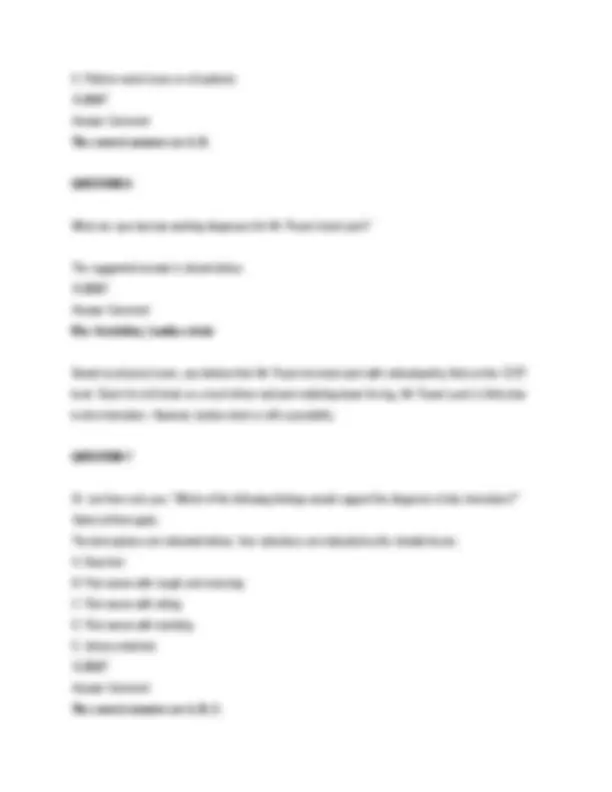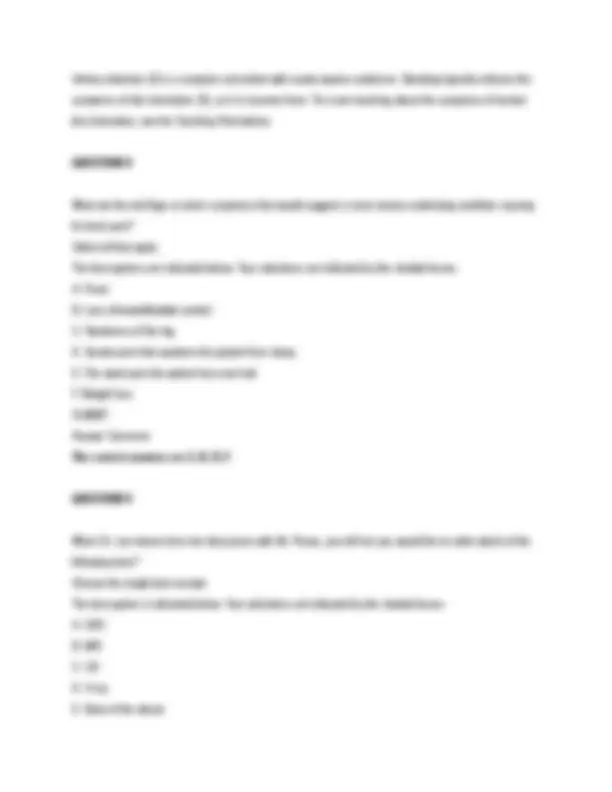






Study with the several resources on Docsity

Earn points by helping other students or get them with a premium plan


Prepare for your exams
Study with the several resources on Docsity

Earn points to download
Earn points by helping other students or get them with a premium plan
Community
Ask the community for help and clear up your study doubts
Discover the best universities in your country according to Docsity users
Free resources
Download our free guides on studying techniques, anxiety management strategies, and thesis advice from Docsity tutors
AQUIFER: Family Medicine 10: 45-year-old male with low back pain ACTUAL CASE STUDY QUESTIONS AND ANSWERS ARE BOLDED QUESTION 1 Dr. Lee tells you: "Working from such a broad list is difficult. Having a shorter list of working diagnoses will help you conduct a more focused initial history and physical exam. What are the three most common causes of back pain?" Select all that apply. The best options are indicated below. Your selections are indicated by the shaded boxes. A. Degenerative joint disease B. Disc herniation C. Kidney stones D. Lumbar strain E. Pyelonephritis F. Spinal stenosis SUBMIT Answer Comment The correct answers are D, B, A. QUESTION 2 Before you meet Mr. Payne, you pause to consider the relevant history to gather for back pain. What questions should you include in your history that would help you narrow your differential diagnosis? Select all that apply. The best options are indicated below. Your selections are indicated by the shaded boxes. A. Aggravating or alle
Typology: Exercises
1 / 8

This page cannot be seen from the preview
Don't miss anything!





AQUIFER: Family Medicine 10: 45-year-old male with low back pain ACTUAL CASE STUDY QUESTIONS AND ANSWERS ARE BOLDED QUESTION 1 Dr. Lee tells you: "Working from such a broad list is difficult. Having a shorter list of working diagnoses will help you conduct a more focused initial history and physical exam. What are the three most common causes of back pain?" Select all that apply. The best options are indicated below. Your selections are indicated by the shaded boxes. A. Degenerative joint disease B. Disc herniation C. Kidney stones D. Lumbar strain E. Pyelonephritis F. Spinal stenosis SUBMIT Answer Comment The correct answers are D, B, A. QUESTION 2 Before you meet Mr. Payne, you pause to consider the relevant history to gather for back pain. What questions should you include in your history that would help you narrow your differential diagnosis? Select all that apply. The best options are indicated below. Your selections are indicated by the shaded boxes. A. Aggravating or alleviating circumstances
B. Any numbness or tingling? C. Any weight loss D. Does the pain radiate? E. Fever or chills F. Is the pain constant or remitting? Is it present at night? G. Location of the pain H. Medical history I. Surgical history J. Using a pain scale of 0 to 10, where 0 is no pain and 10 is the worst pain: "How bad does your pain get?" K. What is the duration of the pain? L. What type of pain is it? Is it dull, achy, sharp, or stabbing? SUBMIT Answer Comment The correct answers are A, B, C, D, E, F, G, H, I, J, K, L. QUESTION 3 From the following, select the top four diagnoses on your differential for low back pain in this patient. The best options are indicated below. Your selections are indicated by the shaded boxes. A. Ankylosing spondylitis B. Cauda equina syndrome C. Degenerative arthritis D. Disc herniation E. Lumbar strain F. Malignancy G. Prostatitis H. Pyelonephritis I. Spinal fracture J. Spinal stenosis K. Spondylolisthesis SUBMIT
E. Perform rectal exam on all patients. SUBMIT Answer Comment The correct answers are A, D. QUESTION 6 What are your top two working diagnoses for Mr. Payne's back pain? The suggested answer is shown below. SUBMIT Answer Comment Disc herniation, Lumbar strain Based on physical exam, you believe that Mr. Payne has back pain with radiculopathy, likely at the L5/S level. Given his risk factor as a truck driver and pain radiating down his leg, Mr. Payne's pain is likely due to disc herniation. However, lumbar strain is still a possibility. QUESTION 7 Dr. Lee then asks you: "Which of the following findings would support the diagnosis of disc herniation?" Select all that apply. The best options are indicated below. Your selections are indicated by the shaded boxes. A. Drop foot B. Pain worse with cough and sneezing C. Pain worse with sitting D. Pain worse with standing E. Urinary retention SUBMIT Answer Comment The correct answers are A, B, C.
Urinary retention (E) is a symptom consistent with cauda equina syndrome. Standing typically relieves the symptoms of disc herniation (D), so it is incorrect here. For more teaching about the symptoms of lumbar disc herniation, see the Teaching Point below. QUESTION 8 What are the red flags or alarm symptoms that would suggest a more serious underlying condition causing his back pain? Select all that apply. The best options are indicated below. Your selections are indicated by the shaded boxes. A. Fever B. Loss of bowel/bladder control C. Numbness of the leg D. Severe pain that awakens the patient from sleep. E. The worst pain the patient has ever had F. Weight loss SUBMIT Answer Comment The correct answers are A, B, D, F. QUESTION 9 When Dr. Lee returns from her discussion with Mr. Payne, you tell her you would like to order which of the following tests? Choose the single best answer. The best option is indicated below. Your selections are indicated by the shaded boxes. A. CBC B. MRI C. UA D. X-ray E. None of the above
Answer Comment Yes, recommending physical therapy as it may be beneficial in preventing a recurrence of his condition. TEACHING POINT Effectiveness of Physical Therapy for Acute Back Pain There is some data to show that tailored physical therapy is slightly more effective for acute back pain compared to patients who just stay active. At four weeks, patients who received physical therapy had 10- point improvement in a 100-point disability score compared to the control group. There is great variation in physical therapy because various interventions (exercises, traction, massage) and different modalities (heat, ice, ultrasound) may be used. There is also evidence that spinal manipulation is safe and can help in the short term. QUESTION 12 Mr. Payne asks Dr. Lee: "What's the likelihood that this pain will go away completely?" Select all that apply. The best options are indicated below. Your selections are indicated by the shaded boxes. A. It is more common for patients with psychosocial distress to recover. B. Longer time to recovery is associated with older patients. C. Most back pain is improved in 4 to 6 weeks. D. Recurrence rate for back pain varies from 35% to 75%. SUBMIT Answer Comment The correct answers are B, C, D. QUESTION 13 What are the treatment options for Mr. Payne? Select all that apply. The best options are indicated below. Your selections are indicated by the shaded boxes.
A. Acupuncture B. Epidural injection C. It has only been five weeks, continue with current treatment D. Osteopathic manipulation E. Surgery SUBMIT Answer Comment The correct answers are A, C, D, E.